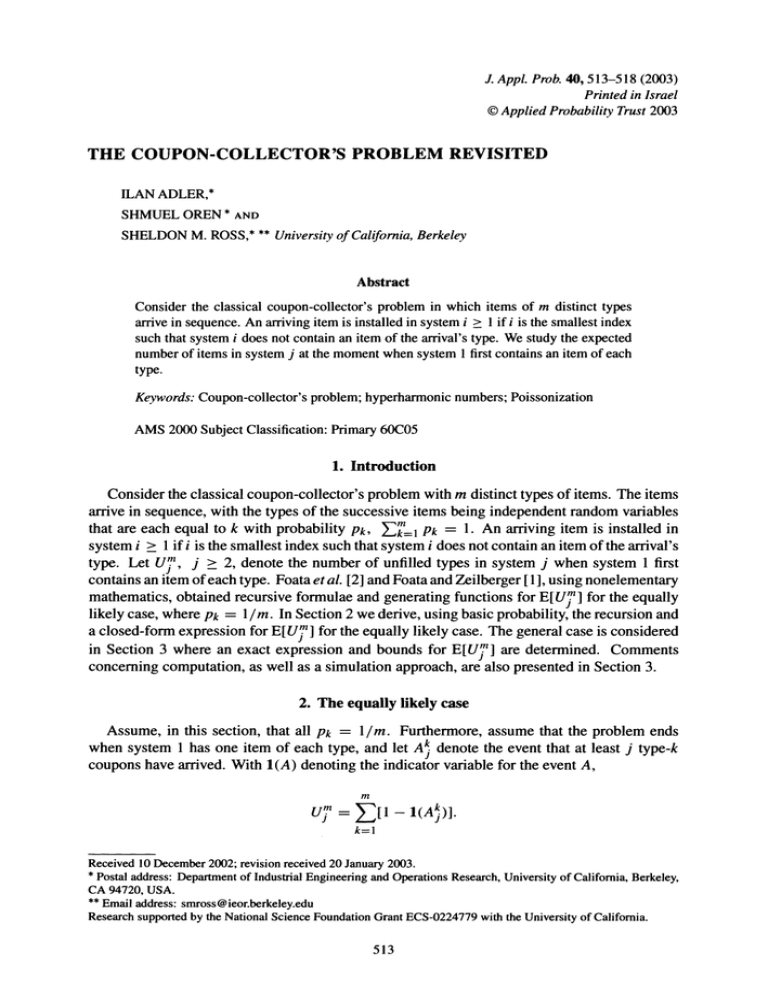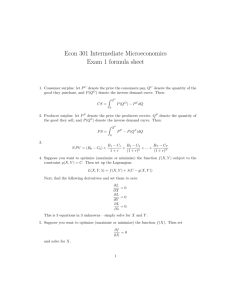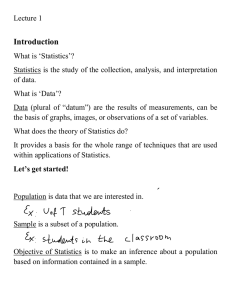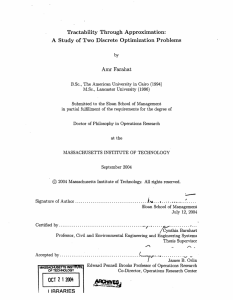THE COUPON-COLLECTOR'S PROBLEM REVISITED
advertisement

J. Appl. Prob. 40, 513-518 (2003)
Printed in Israel
? AppliedProbabilityTrust2003
THE COUPON-COLLECTOR'S PROBLEM REVISITED
ILAN ADLER,*
SHMUELOREN * AND
SHELDONM. ROSS,*** Universityof California,Berkeley
Abstract
Consider the classical coupon-collector'sproblem in which items of m distinct types
arrivein sequence. An arrivingitem is installedin system i > 1 if i is the smallest index
such that system i does not contain an item of the arrival'stype. We study the expected
numberof items in system j at the momentwhen system 1 firstcontainsan item of each
type.
Keywords:Coupon-collector'sproblem;hyperharmonicnumbers;Poissonization
AMS 2000 SubjectClassification:Primary60C05
1. Introduction
Consider the classical coupon-collector's problem with m distinct types of items. The items
arrive in sequence, with the types of the successive items being independent random variables
that are each equal to k with probability pk, Ek=l Pk = 1. An arriving item is installed in
system i > 1 if i is the smallest index such that system i does not contain an item of the arrival's
type. Let UJ, j > 2, denote the number of unfilled types in system j when system 1 first
contains an item of each type. Foata et al. [2] and Foata and Zeilberger [1], using nonelementary
mathematics, obtained recursive formulae and generating functions for E[UT] for the equally
likely case, where pk = 1/m. In Section 2 we derive, using basic probability, the recursion and
a closed-form expression for E[Uj] for the equally likely case. The general case is considered
in Section 3 where an exact expression and bounds for E[Uj] are determined. Comments
concerning computation, as well as a simulation approach, are also presented in Section 3.
2. The equally likely case
Assume, in this section, that all Pk = 1/m. Furthermore, assume that the problem ends
when system 1 has one item of each type, and let Ak denote the event that at least j type-k
coupons have arrived. With 1(A) denoting the indicator variable for the event A,
m
U? = E[1
- 1(Ak)].
k=l
Received 10 December 2002; revision received 20 January2003.
* Postal address:
Departmentof IndustrialEngineeringand OperationsResearch,Universityof California,Berkeley,
CA 94720, USA.
** Email address: smross@ieor.berkeley.edu
Researchsupportedby the National Science FoundationGrantECS-0224779 with the Universityof California.
513
514
I. ADLER ETAL.
Thus,
m
E[Um] = E[1-
P(Ak)]
k=l
=m[l
- P(Am)].
(1)
Let Be. denote the event that at least j type-m coupons arrive before the first coupon of
J,I
type i arrives. Then
m-1
P(A)
= P(
Bji)
and the inclusion-exclusion probability equality give (for j > 2)
m-1
L
:(,~)_C-i)k+l
(-1)k+
P(A7) =
k=1
P(BTmi
P(Bj,,
E
il<i2<'
... * B
BJ,ik)
<ik
m-l
=
k=l
-1)k+l
(
I)
m-(k
Using (1), this gives the following result.
Proposition 1. For j > 2,
m (m)
i-j
Next, using basic probability arguments, we obtain a recursive expression for E[Uj ] that
was first presented in [1] and [2]. Let Ck be the event that at least j type-k coupons have already
arrived at the moment when each of the item types 1,..., k - 1 has arrived. Also, let Xk be the
number of types 1, ..., k - 1 that have not yet arrived when the first coupon of type k arrives.
With Pk = P(Ck), we obtain that
k-I
k =
P (Ck
Xk =r)
r)(X
r
r=O
k-I
-=
?
k
' pr+l
r=O
/ -1
k
-k E
-i
(2)
r=l
where Pk = (k - 1)/k fork = 1, 2,....
Substituting Am = Cm for j > 2 into (1) gives
E[Um] = ml - Pm],
2.
j
Thus, using (2) and (3), we obtain that
m
E[U=] =- m -
r
r=1
r=l
m
r
k=lk
(3)
The coupon-collector'sproblemrevisited
515
and, for j > 3,
m
E[U7]
=m-E
Pi-
k-i
k=l
I
-E[UJ-k
= m-E(1
_
m
E[O
E[U_1]
k=l
We have thus proven the following.
Proposition 2. We have
m
E[U2 ] =
k=l
and, for j > 3,
k
m E[Uk_ ]
E[Uj?]
=j E
k=l
Remark 1. Equating the two expressions for E[UJ'] given by Propositions 1 and 2 yields an
explicit expression for the hyperharmonic number, which is defined in [2] by the recursive
formula given in Proposition 2.
3. The general case: Poissonization
In the general case, we suppose that each item is of type k with probability Pk, Lkml Pk = 1.
To analyze this case, let us start by assuming that, rather than stopping when system 1 is filled,
items continue coming forever. Suppose also that successive items arrive at times distributed
according to a Poisson process with rate 1. Under this scenario, the arrival processes of the
distinct types are independent Poisson processes, with respective rates Pk, k = 1, ..., m.
Because 1 - P(Ak) denotes the probability that there have been less than j type-k arrivals when
system 1 becomes full, we obtain upon conditioning on the arrival time of the jth item of type k
that
1-1P(Ak
P(Aj)
0I
pkPkX
(pkx)'j-
pke-PX (
) n
-e-Pix)dx,
j > 2.
(4)
The expected numberof unfilled slots in system j is now obtainedfrom
m
E[UJ7] = Z[1
- P(A5)],
j > 2.
(5)
k=1
The following lemma will be used to obtain bounds on E[UJ].
Lemma 1. For positive values xi, f1=l (1 - e-xi)
, Yr), where yi = ln(xi).
(Y1,
is a Schur concave function of y =
I. ADLER ETAL.
516
Proof With y = In(x),
-(1 -e-X) = xe-X
ay
Because ln(x) in increasingin x, by the Ostrowskicondition for Schur concavity (see [3]) it
suffices to show that
> x2e-X2(1
(1-e-X2)
xle-I
But this inequality follows because xe-X /(
if XI < x2.
-e-X)
- e-X) is a decreasing function of x.
Lower and upper bounds on E[UJ], fairly tight for values of (Pl, P2, ....
(1/m, l/m, .., l/m), can be obtained from the inequalities
(1 -
<
e-mkx)m-1
nH(
- ePix)
< (1 - e-
P)
close to
")
(6)
i#k
That is, gk is the geometric mean of the
where mk = minigk{pi) and gk = (f-ifk Pi)l/(m-l)
values pi for i : k. The second inequality of (6) follows from Lemma 1.
We obtain from (4) and (6) that
1- P(AJ)
k
ke -PkX (p
(j
<
1)I
-
'
(1 - e-gkx)m-1 dx
m- p-(rm-+Pk)x
(m- 1)(l)r
(PkX)j- l dx
ke-(rgk+
P
k)
m=
r=O
r
r=
=
rgk + Pk
(m -
ri 1
Pk
)(rl(
(j-)!
.
)
? Pk.
X = rgk
where A
Pk. Substituting the preceding inequality into (5) and considering both
rgk +
(6)
inequalitiesof~0^
~~gives
~
rgk+ Pk
r=
E() r) r
r=0
r )rmk
k=l
+pk
< E[Um] < EI)r
+Pk
(r
r=O
Pk
)
- rglk=lrgk?- Pk
(7)
We will now derive a second set of lower and upper bounds for E[UJ ]. Let Bki denote the
event that at least j coupons of type k arrive before the first of type i arrives. Then, using the
conditional expectation inequality (Proposition 3.2.3 of [5]), we obtain that
P(A?)
-
P(U
Bj,i
>
i
i1 1 +
+
P(Bk,
i) )
p(Bj
Er:i,k
?
_ 1yF
-
i~k
r+ ri,k((Pk
(8)
P(MJ,r lB,)jk
(Pk/(Pk + Pi))j
+ Pi)/(Pk
+ Pi + Pr))'
517
The coupon-collector'sproblemrevisited
where (8) follows from the conditionalexpectationinequalityand (9) from
k
P(Bjj,r
,ir
Bk,i' ) = P(BkrBki)
n'
P(Bkj
P(Bj,)
+ Pi + Pr))j
(Pk/(Pk
(Pk/(Pk + Pi))'
=
Pk + Pi
(
)
Pk + Pi + Pr J
Therefore,we obtainour second upperbound for E[Uj ] =
m
<m-L
E[Ujm]
<
JE[?
m Ek
-
km1[1- P(Ak)]:
PiW
?(Pk/(Pk+
+
+
Pi)J/(Pk + Pi + Pr
1 Erfi,k(Pk
(10)
(10)
To obtain a lower bound, let Xi denote the time of the firsttype-i event, and let Tk denote
the time of the jth type-k event in the Poissonizationscheme (which results in Tk and Xi for
i =k being independent).Then, from (4),
1-P(A5)=E
fl(-e-PT'k
-i:k
whenever f and g are
> E[f(X)]E[g(X)]
Using the well-known result that E[f(X)g(X)]
increasing functions [4, p. 339], which easily generalizes to the product of any number of
positive increasing functions, the preceding equation yields that
1-P(Ak)
>
PiT"]
E[1-e
ifk
P(Tk > Xi)
=
i#k
=
- p(Tf < Xi)]
H[
i#k
J
Pi +Pk
t-k -(
i9kThus, we have the lower bound
k= ik
iOurputi
l
i
-
(
if
Pk
)
i
i
k
Remark 2. (i) Our computational experiments verify that the bounds given in (7) work well
for probabilities pi which are roughly the same, while the bounds given in (10) and (11) are
tighter otherwise.
(ii) For the equal-probabilities case, the explicit expression for E[Uj ] of Proposition 1 is faster
to compute than the recursive expression of Proposition 2. However, for large m (say m > 150),
the explicit expression (but not the recursive one) is computationally unstable.
518
I. ADLER ETAL.
(iii) For very large m, simulation can be employed to efficiently estimate E[UT]. The following
simulation approach estimates 1 - P(Ak) by a conditional expectation estimator that conditions
on the arrival time of the jth item of type k; the estimator is then further improved by the use
of antithetic variables.
* Generate random numbers Ul,...,
* let L1 = ln(Fnl
Uj;
Ui) and L2 = ln(Ji(l
* set
- U));
1 m V=
E
n
(l -ePiLI/Pk) I +
k=l -i#:k
(l -ePiL21/p)
i:k
The preceding should be repeated many times, with the estimator of E[U ] being the average
of the values of V obtained.
References
D. ANDZEILBERGER,
D. (2002). The collector'sbrotherhoodproblemusing the Newman-Sheppsymbolic
[ 1] FOATA,
method.To appearin Algebra Univ.
D., Guo-Niu, H. ANDLASS,B. (2001). Les nombreshyperharmoniqueet la fratriedu collectionneurde
[2] FOATA,
vignettes. Sem. Lothar.Combinatoire47, B47a (electronic).
A. W. ANDOLKIN,I. (1979). Inequalities:Theoryof Majorizationand Its Applications(Math. Sci.
[3] MARSHALL,
Eng. 143). Academic Press, New York.
[4] Ross, S. M. (1996). StochasticProcesses, 2nd edn. JohnWiley, New York.
[5] Ross, S. M. (2002). ProbabilityModelsfor ComputerScience. Academic Press, New York.










